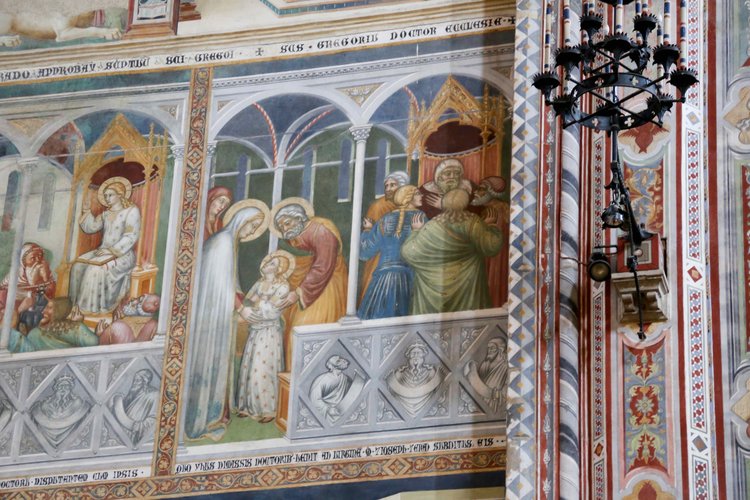The Holy Family in the frescoes of the Orvieto Duomo
John Skillen (2016)
Ugolino di Prete Ilario’s visual narration of Mary’s life exhibits an unusual attention not just to the sanctity of the Virgin herself but, as Sara Nair James writes, to “intimate glimpses” of the holy family’s daily life, of the “tenderness of human interactions” involving Jesus’s adoptive earthly father Joseph as well as Mary.
The cycle of frescoes on the theme of the End Times and the Last Judgment in the Orvieto Duomo is recognized as one of the major artworks of the High Renaissance in Italy. (The frescoes fill the right transept chapel often referred to as the San Brizio Chapel.) This work, begun around 1450 by Fra Angelico and completed 50 years later by Luca Signorelli, has received plenty of scholarly attention, including a book by a close friend of the Studio for Art, Faith & History, art historian Sara Nair James: Signorelli and Fra Angelico at Orvieto: Liturgy, Poetry and a Vision of the End Time.
Of enormous local significance is the earlier fresco cycle in the left transept chapel – the Chapel of the Holy Corporal – by Orvietan painter Ugolino di Prete Ilario, completed in 1364 with Eucharistic themes. Featured is the story of the Host that dripped real blood on the altar cloth in the pilgrimage church of Santa Cristina in nearby Bolsena, understood in Orvietan tradition as the miracle that prompted Pope Urban IV to institute the Feast of Corpus Christi in 1264 from the Pope’s residence in Orvieto.
Largely ignored, however, by scholars and visitors alike is the large fresco cycle behind the altar devoted to episodes of the life of the Virgin Mary. Sara James is the first art historian to give careful attention to this cycle in a lengthy article in the academic journal Gesta (Spring 2016, v. 55, n.1, pp. 79-104). My brief essay here is neither a review nor a summary of Professor James’s article but a description of the cycle through eyes opened by James’s study to features transparently present in Ugolino’s visual narration.
With construction underway by 1290 on a new cathedral in Orvieto, Pope Nicholas IV dedicated the Duomo to the Virgin Mary, particularly in the aspect of her bodily assumption into heaven soon after her death.
The Assumption was declared as a dogma of the Church only in 1950. It has no clear grounding in scripture, but early references to the idea occur by the 4th and 5th centuries. In fact, St. Juvenal – the Bishop of Jerusalem and understood to be the same Juvenal (to whom the beloved church of San Giovenale in Orvieto is dedicated) who evangelized southern Umbria and became bishop of Narni – is cited by St. John of Damascus as declaring at the Council of Chalcedon (451) to the Emperor Marcian, “who wished to possess the body of the Mother of God,” that Mary died “in the presence of all the Apostles, but that her tomb, when opened, upon the request of St. Thomas, was found empty; wherefrom the Apostles concluded that the body was taken up to heaven.”
In 1370 the administrators of the Duomo again turned to Ugolino di Prete Ilario to decorate in fresco the most important area inside a cathedral dedicated to the Assumption of the Virgin, namely, the space surrounding the altar at the East end of the Duomo (the tribune or apse).
Cathedral records indicate that Ugolino and his workshop worked for over a decade on what remains the largest Marian cycle in western Europe, both in square footage (300 square meters) and in number of scenes (more than 30 captioned panels). The narrative culminates in the highest area of the East wall with five scenes: the Angel announcing to the aged Mary her impending death; her death (the Dormition); the disciples processing the dead Mary to her sepulcher; Jesus raising Mary from her tomb; and, in the high arch above the central window, her Assumption into heaven witnessed by the disciples. Directly above the Assumption in the triangular space of the ceiling vaulting is the Crowning of Mary by her Son.
Arranged in a left-to-right U-pattern on two registers circling the lower and larger area of the apse are scenes from the life of the Virgin. Included are the beloved episodes from the apocryphal accounts of the young Mary, featured in most of the Marian cycles. Her miraculous birth to her aged parents Anna and Joachim fills the lowest register on the north wall (the left side, facing the altar). Mary’s entrance into the Temple as a young girl and her marriage to Joseph are depicted at the bottom of the east wall. The Annunciation and the Visitation, the Nativity and the Adoration of the Shepherds and of the Magi, the Presentation of baby Jesus in the Temple, and the Flight into Egypt all find their place in the Ugolino’s cycle.
But Ugolino’s narration of Mary’s life contains some strikingly a-typical elements. Viewers familiar with other Marian cycles (such as Giotto’s in the Scrovegni Chapel in Padova) may notice an unusual attention not just to the sanctity of the Virgin herself but, as Sara Nair James writes, to “intimate glimpses” of the holy family’s daily life, of the “tenderness of human interactions” involving Jesus’s adoptive earthly father Joseph as well as Mary.
In fact, most unusual in a cycle devoted to Mary is the strong role of Joseph, often placed center stage by Ugolino. Joseph’s high profile in the Duomo cycle is perhaps not entirely surprising, given the veneration he received in Orvieto with the arrival of the mendicant orders in the 13th century, especially the Servites, whose annals for 1324 indicate a long-standing annual festival in honor of Joseph. Such veneration culminated in the official declaration of Joseph as patron saint of Orvieto in 1652.
For example, Ugolino’s Nativity scene focuses simply on Joseph and Mary kneeling before the newborn babe lying on the ground between them, but Joseph is the figure at the center of the visual field. In the scene of the Adoration of the Magi, Joseph in fact is placed at the apex of the pyramidal arrangement of the four men, his own hands raised in amazed adoration. In the Presentation in the Temple, Simeon holds the baby Jesus in front of the altar, while Joseph interacts with the priest behind the altar; in the background but at the center. Joseph again occupies a central position in the Circumcision, turning to Mary with a look of fatherly concern.
The sequence of four scenes on the lower register of the South wall begins with the Annunciation. But Joseph figures prominently in the other three episodes. In the Visitation the two husbands Joseph and Zacharias visually frame the embrace of Mary and Elizabeth in the center (although the men’s presence is not in the scriptural account). The last episode in this sequence depicts Joseph welcoming Mary into his house. Mary enters the scene on the left, but Joseph is the central figure, with some musicians on the right supplying festive accompaniment – nothing hugger-mugger here.
As for Ugolino’s interpretation of the Flight into Egypt (a much damaged section of the wall), Joseph leads the donkey, but the Flight itself occupies only half the space. In the entirely unusual right half of the panel, Ugolino depicts the Holy Family at home, with Joseph the blacksmith working outside at his anvil and forge, while Mary seems to be “homeschooling” young Jesus inside!
Perhaps most surprising is Ugolino’s treatment of the story of Jesus at the age of twelve, having accompanied his parents to the Passover Festival in Jerusalem, but staying behind asking astute questions of the Teachers in the temple courts (Luke 2:41-52). The story is typically compressed into a single scene with Jesus seated in the center and the Jewish elders symmetrically-arranged on either side (as in Maitani’s depiction on the façade of the Duomo, and in Giotto’s cycle in Padova).
Photo Madeleine Linnell
Photograph from OPSM
In Ugolino’s cycle, the story becomes an intimate family drama expanded to five scenes and filling the entire upper register on south wall (the same proportion as given to Mary’s own birth narrative). Joseph figures prominently in every scene. The first panel depicts the family on their journey to Jerusalem. In the next they stand before the temple (appearing rather like the Duomo itself), Joseph kneeling at the boy’s side apparently giving a lesson. In the middle scene, Joseph and Mary discover that Jesus is missing. A dramatic empty space opens between the two parents, their hands clasped to chests. The fourth scene depicts Jesus among the Elders, the teachers responding variously. The boy’s position on the right side creates a visual juxtaposition with his position on the left in the final scene. There, the boy who has just been speaking authoritatively to his elders is reunited submissively to his parents. The caption below the scene reads: “Where Jesus dismisses the doctors; He comes to the Virgin Mary [and] Joseph [and] ardently submits to them.”
To be sure, the saintly Virgin is highlighted in the culminating central height of the long cycle. But the visual experience of the viewer working her way through the larger portion of the cycle creates a strong experience of parents – of a fully engaged earthly father along with a devoted mother – working in concert to raise their boy in godliness. Perhaps we may perceive the lesson that, even for Jesus, learning obedience to his heavenly father began with training in obedience to his earthly father. As for Virgin, the cycle presents her as the vessel of God’s humanity in Jesus, not just in the womb but in his upbringing.
Perhaps in Ugolino’s Marian cycle we are invited to understand the doctrine of Mary’s Assumption into heaven as grounded solidly in her – and her husband’s – day-to-day fidelity to the task of rearing the Messiah. And we are invited to see even the Virgin of the Assumption not as an otherworldly saint sailing effortlessly up to heaven but as the wife and mother – faithful in the callings to which we, too, are called – who goes before us as promise and anticipation of our own bodily resurrection.
In sum, we can say that the Marian cycle in the tribune provides another element in the theme everywhere addressed in the entire decoration of the Duomo: the doctrine of the Incarnation. Taken together with the façade and the two transept chapels, we see God creating our first parents in his own image (even shaping Adam with the implements of the sculptor) and becoming fully incarnate in the Word made Flesh (the sculpted reliefs on the façade); really present in the Sacrament (Chapel of the Holy Corporal); initiating a New Creation of redeemed humanity not by eliminating flesh but by raising it anew in perfection through the One, wounds in hands, who exercises mercy and judgment (Chapel of San Brizio).
Photograph credits to Gianna Scavo (unless otherwise indicated)


















